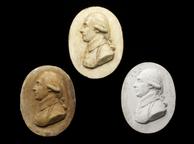

Desk with two drawers
- Made:
- 1790-1819
Wooden standing desk with two drawers, L. hand empty
This item is part of the contents of the workshop that Scottish engineer James Watt developed at his home, Heathfield, at Handsworth, Birmingham, from c.1795 through to his death in 1819. Although Watt is best known for his work on the steam engine, his workshop contains a wide variety of objects from many different projects, from chemistry to sculpture-copying.
The description of the item was written by Edward Collins, the land agent responsible for Heathfield when the workshop was given to the Science Museum in 1924. Collins could not always identify what he was looking at, but always described what he saw clearly. This has allowed his descriptions to form the basis of subsequent research.
This is a high desk, in deal, with writing-slope, flat ledge at back and one shallow drawer in each end. A batten, nailed on near the fore-edge to form a stop to prevent ledgers from sliding from the desk, has been worm-eaten and only a portion of it, to the right, remains. Is this article unusual, as a survival of ordinary office furniture? The desk stands in the corner of the room, so that the left drawer cannot be opened. This drawer is empty. The right drawer opens toward the lathe, and can easily be reached when standing at the lathe, so its use to contain turning tools, as described below, makes good sense. On the other hand, there is some reason to suppose that this may not have been Watt’s own arrangement.
Details
- Category:
- James Watt's Garret Workshop
- Object Number:
- 1924-792/2446/2
- Materials:
- wood, deal
- type:
- desk
- credit:
- Major J.M. Gibson-Watt



